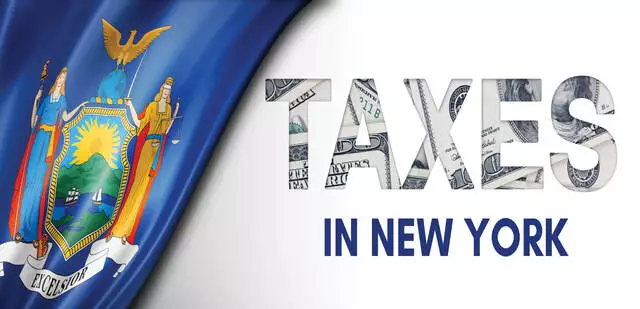
“Mr. Speaker, the Editor-in-Chief of the TiNY Report.”
“Thank you. According to our subscriber statistics, TiNY added two loyal readers since last year. But we lost one of our original twelve to retirement. So, the net gain in loyal readers is plus-one, and our loyal readership is now thirteen!
“During the last year, the Editor-in-Chief undertook a mental ‘walk about’ a couple of times, leaving TiNY readers in a lurch. Now we have two additional writers to make certain we don’t go off the rails again.
“To summarize, the state of the TiNY Report is strong.”
And now back to our regularly scheduled programming.
In other New York State tax news: The New York State Assembly and Senate are working on their “one-house” budget bills so budget negotiations can progress as the April 1 deadline approaches. Some media outlets (e.g., Spectrum News) have said that the Democrats who control the Senate and Assembly are reportedly considering new “wealth taxes” as part of their discussions. If you are an appraiser or a state tax lawyer (like us!), new wealth taxes will be great for business. But, in the long run, such taxes will simply accelerate the movement of wealthy individuals out of the State, which is bad news for New York. And, along those lines, State Comptroller Thomas DiNapoli and Business Council President Heather Briccetti Mulligan had a joint Op-Ed published in the New York Daily News on Friday, March 8. The Op-Ed discussed New York’s recent and significant out-migration, particularly among those working in the financial service industry, and what that might mean for the State’s fiscal stability. And it ain’t good. The not-so-subtle message to the Legislature: “Be very careful. New York is teetering on the edge of the abyss.” Briccetti Mulligan is the leader of the State’s most visible and important pro-business association. DiNapoli is a Democrat. When they get together on an issue, legislators should take note.
But at least TiNY is in good shape, right?
A Tribunal decision and two ALJ timies were issued by the DTA on March 7, 2024. The Tribunal decision was on a cigarette tax penalty issue. Those sometimes get my blood a-boil, but this one did not. Am I mellowing?
Not likely.
Determinations
Matter of Algrant (ALJ Maloney, February 29, 2024); Div’s Rep. Peter Ostwald, Esq.; Pet’s Rep. pro se; Article 22/Timey (Pete Calleri).
Another typical timey, typical result here. The Division proved its standard mailing practices and that they were followed when it mailed the Notice of Deficiency to Petitioner’s last known address on December 30, 2021, thereby starting the statutory 90-day time limit to file a BCMS request. Petitioner filed his BCMS request almost a year later on December 1, 2022, which was untimely.
Matter of Blenderman (ALJ Russo, February 29, 2024); Div’s Rep. Maria Matos, Esq.; Petitioners’ Rep. Ron Friedman, CPA; Article 22 (Zoe Peppas).
Yet another typical timey. Petitioners, who ought to own a few Jimmy Buffet restaurant franchises, received a Notice of Deficiency dated July 11, 2022. They had 90 days to respond. Petitioners filed a request for BCMS in protest of their Notice on December 15, 2022.
BCMS issued a conciliation order dismissing Petitioners’ request due to its untimeliness. Petitioners, though, then filed a timely petition with the Division of Tax Appeals protesting the order. The Division of Tax Appeals had jurisdiction over that petition and could consider the timeliness of Petitioners’ BCMS request. The Judge held that “[i]t is well established that the 90-day statutory time limit for filing either a petition or a request for a conciliation conference is strictly enforced and that, accordingly, protests filed even one day late are considered untimely.” The Division was able to demonstrate its standard mailing procedures and that they were followed when it mailed the Notice to Petitioners’ last known address. Since Petitioners did not respond to the Division’s Notice within the required 90 days, the Judge granted summary determination in favor of the Division.
Decision
Matter of Patel (February 29, 2024); Div’s Rep. Elizabeth Lyons, Esq.; Pet’s Rep. Philip Vecchio; Article 20/Cigarette Tax Penalty (Chris Doyle).
On June 20, 2018, a couple of the Division’s investigators found a bunch of untaxed cigarettes and tobacco products at a store owned by a corporation owned by Petitioner. Petitioner wasn’t at the store at the time of the search and seizure. But some paperwork that was reviewed as part of the store seizure listed a home address for Petitioner. The investigators discovered a rental van at Petitioner’s home, and a non-invasive search disclosed that it was likely the van contained cigarettes. From the Decision: “[The investigator] walked through the parking lot to the van where he could clearly see boxes labeled with known tobacco brands inside of the back storage compartment of the van.” Clearly, Petitioner was not a Lex-Luthor-level criminal mastermind. On June 22, 2018, the Division seized another bunch of cigarettes and a half-ton of other tobacco products from the van.
With respect to the seizure at the store, on January 23, 2019, Petitioner pled guilty to disorderly conduct at the Niskayuna Justice Court, was sentenced to a conditional discharge, and was required to pay $882.69 in restitution. Less than a month later, on February 19, 2019, the Division issued a Notice to Petitioner asserting a civil tax penalty of $15,000. Before she pled guilty, was Petitioner or her attorney informed that Petitioner could be liable for both restitution and a penalty? The Decision is silent on the issue, but experience suggests that Petitioner was not warned of the possibility. Otherwise, she would have negotiated the penalty as part of the criminal case. Regardless, Petitioner was certainly on notice as of the end of February 2019 that both restitution and a penalty might be asserted.
With respect to the seizure from the van, on October 11, 2019, Petitioner pled guilty to disorderly conduct at the Niskayuna Town Court and paid restitution of $7,743.81. Petitioner was also required to pay “a penalty” of $15,000 to the Niskayuna Justice Court as a condition of her sentence. I assume that was the penalty asserted on the February 19, 2019, notice.
Less than three months after the sentencing for the van seizure, the Division issued a Notice to Petitioner asserting another $15,000 penalty. Petitioner was shocked and appalled. If you are like me, you’re probably thinking “Shouldn’t Petitioner have assumed she’d get a penalty notice for the second seizure after she received one for the first seizure?”
Petitioner filed a petition challenging both $15,000 penalties. At the hearing, Petitioner argued that the store seizure and the van seizure constituted a single incident and that she should therefore pay only one $15,000 penalty. The ALJ disagreed and found that there were two seizures, from two locations, two days apart, meriting two penalties. In addition, the ALJ found that the penalties were not excessive under the Constitution. The Tribunal agreed with the ALJ. In addition, the Tribunal found that the imposition of the double penalties did not violate the “Double Jeopardy” clause of the Fifth Amendment.
Petitioner was engaged in a criminal enterprise and, it could be argued, got what she deserved. But I don’t want to let the State off the hook entirely. It seems to me that both judicial economy and common-sense mandate that the penalty should have been addressed at the time Petitioner entered her guilty plea. There is a concept in civil procedure called “issue preclusion” that normally requires a plaintiff to raise every legal complaint arising out of an incident in a single case. Plaintiffs are not permitted, for instance, to bring suit for property damage and another suit for personal injury if both the damage and the injury arose from the same event. That the State would intentionally engage in the sort of “bait-and-switch” conduct evident in this case seems sleazy to me. As for this last point, I note that the investigator explicitly “testified that the Second Notice was generated after the matter in the Town of Niskayuna Justice Court had been resolved with the payment made because he does not issue bills until after he receives information back from the court.” So, the State makes a plea deal which the defendant reasonably assumes will draw the matter to a close. Then, the State whacks the defendant with additional Tax Law penalties after the defendant finalizes the plea deal. Like I said, sleazy.



